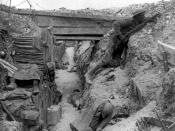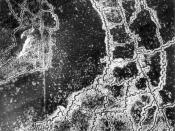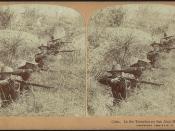Life in the Trenches
After the Battle if the Marine in September in 1914 the German army was forced to retreat. Rather than give up the territory the Germans dug in to protect themselves from the guns and the advancing allies. Soon, the allies followed the Germans in building the trenches. The trench lines spread from the North Sea to Switzerland.
The trenches in both sides were protected by lined barbed wire with open land in between. All the explosions quickly turned the land into a sea of mud and craters. Machine guns were so efficient few attacks on the trenches were successful. Most military attacks ended with few gains and a lot of casualties. On the first day of the Battle of the Somme in 1916, the British Army lost around 20,000 men. The attack cost the Allies over half a million casualties but only penetrated 12km, at most, into German lines.
Front line trenches were about seven feet deep and about six feet wide. The allies were forced to build their trenches in lower ground so it was generally always wet and muddy. The trenches were formed in a zigzag pattern so the enemy wouldn't be able to shoot straight down the line. Sandbags were put in both sides of the trenches to help block and absorb the bullets. Lines of barbed wire helped to prevent attacks from the enemy.
A fire step was cut into the side of the trench to allow the soldiers to peer over the side in the trench towards the enemy. Soldiers would stand in the fire steps when they were "standing to duty" which meant that they were waiting for the enemy to attack.
No mans land was the land that separated the German and the allies trenches and was a wasteland...



Duplicate submission
I just got through reading this same essay.
10 out of 12 people found this comment useful.